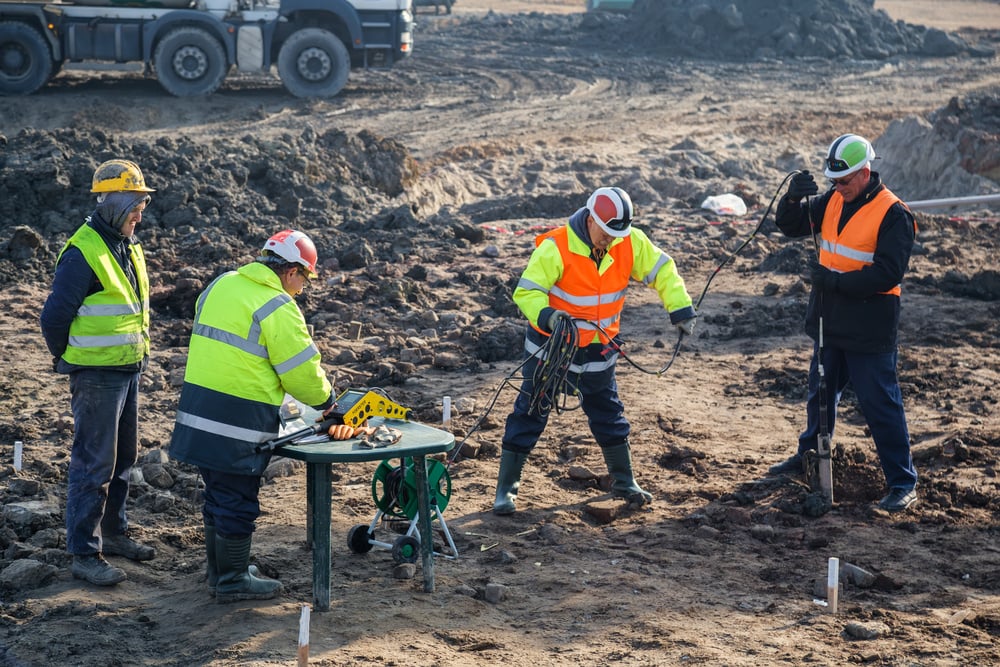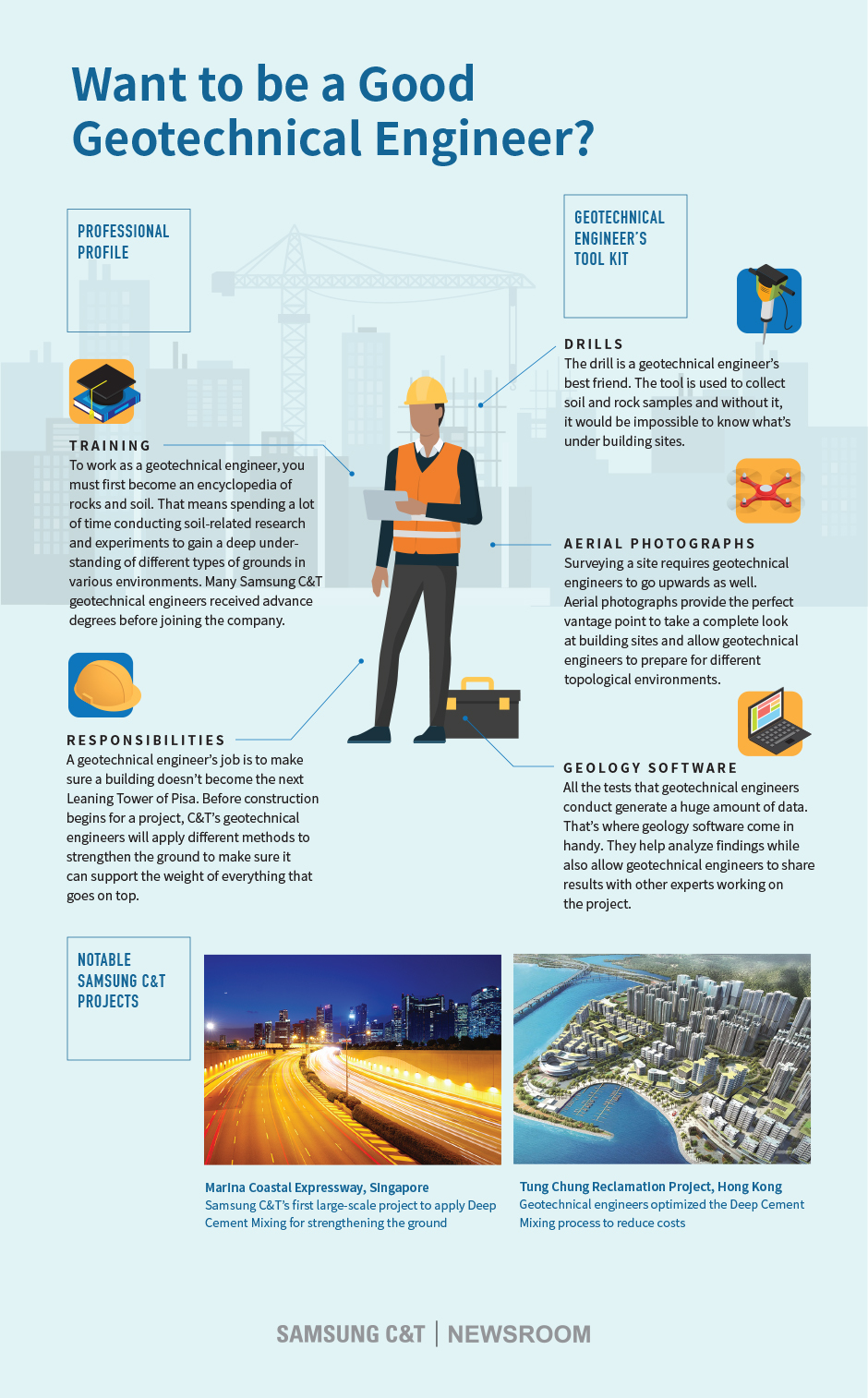Some Known Factual Statements About Geotechnical Engineering For Construction Projects
Some Known Factual Statements About Geotechnical Engineering For Construction Projects
Blog Article
Not known Facts About Geotechnical Engineering For Construction Projects
Table of ContentsGeotechnical Engineering For Construction Projects Things To Know Before You BuyGeotechnical Engineering For Construction Projects for DummiesNot known Details About Geotechnical Engineering For Construction Projects The smart Trick of Geotechnical Engineering For Construction Projects That Nobody is Talking AboutAll About Geotechnical Engineering For Construction ProjectsHow Geotechnical Engineering For Construction Projects can Save You Time, Stress, and Money.The 4-Minute Rule for Geotechnical Engineering For Construction Projects
and Kovacs, W. (1981 ), An Intro to Geotechnical Engineering, Prentice-Hall, Inc. Deep Check Tech (2023 ): Deep Check Tech discovers covert frameworks at the site of Denmark's highest building. "Geofrost Coring". GEOFROST. Fetched 20 November 2020. Han, Jie (2015 ). Principles and Practice of Ground Improvement. Wiley. ISBN 9781118421307. RAJU, V. R.Ground Enhancement Technologies and Situation Histories. Singapore: Research Posting Services. p. 809. ISBN978-981-08-3124-0. Ground Improvement Principles And Applications In Asia. Pariseau, William G. (2011 ). Design analysis in rock technicians. CRC Press. Hegde, A.M. and Palsule P (Geotechnical Engineering for Construction Projects).S. (2020 ), Performance of Geosynthetics Reinforced Subgrade Subjected to Repeated Vehicle Loads: Experimental and Mathematical Researches.
Cengage Understanding, Stamford, 666 p. Atkinson, J., 2007. The technicians of soils and structures. Taylor & Francis, N.Y., 442 p. Drifting Offshore Wind Wind Turbines: Actions in a Sea state Pareto Optimal Designs and Financial Analysis, P. Sclavounos et al., October 2007. Nicholson, D, Tse, C and Penny, C. (1999 ). The Observational Method in ground engineering concepts and applications.
The Ultimate Guide To Geotechnical Engineering For Construction Projects
Research laboratory and area screening plays a critical role in this process. By extracting samples from the earth's subsurface and using a suite of examinations, geotechnical engineers can forecast the behaviour of soil layers and evaluate their suitability for different building endeavours. The essence of geotechnical design in civil design can not be overemphasized, attributable to numerous aspects: The first action in any kind of geotechnical research entails determining the soil kind at the building and construction website.
Comprehending these characteristics ensures that just ideal soil kinds are chosen for the advancement, thereby averting potential architectural failings. The structure works as the bedrock of any type of building project. Choosing the proper structure type is a choice that pivots on the detailed analysis provided by geotechnical design. This ensures the longevity and security of frameworks by accommodating the loads they will bear.

Geotechnical site investigation is a critical step in the preparation and execution of any building task. It entails the collection and evaluation of data connected to the physical homes of dirt and rock under a proposed building website. This info is crucial for the layout and building and construction of risk-free, steady, and lasting frameworks.
Some Known Facts About Geotechnical Engineering For Construction Projects.
In this blog, we will certainly look into the value of geotechnical website examination, its numerous elements, and exactly how it profits building jobs. Geotechnical site investigation, additionally called subsurface expedition, includes a series of tasks intended at figuring out the soil, rock, and groundwater problems at a construction site. The key goals are to determine possible geotechnical hazards, analyze the engineering properties of subsurface materials, and offer recommendations for the style and building and construction of structures, keeping walls, and various other frameworks.
This may include geological maps, aerial photographs, previous examination records, and historical data. The workdesk research study helps in determining prospective geotechnical problems and intending the succeeding fieldwork. Complying with the workdesk research, a site reconnaissance is performed to visually evaluate the website and its environments. This entails observing the topography, drainage patterns, existing structures, plant life, and any indicators of instability or erosion.
What Does Geotechnical Engineering For Construction Projects Mean?
Superficial examination pits are excavated to straight observe and Learn More Here example the soil and rock. This method works for examining the top layers of the subsurface and determining near-surface hazards. Non-invasive geophysical methods, such as seismic refraction, ground-penetrating radar (GPR), and electric resistivity tomography (ERT), are made use of to map subsurface conditions and spot abnormalities.
Dirt and rock samples gathered during the area examination go through research laboratory testing to identify their physical and mechanical residential or commercial properties. Common lab examinations consist of grain size analysis, Atterberg restrictions, compaction examinations, triaxial shear examinations, and consolidation examinations. These tests give important data for geotechnical evaluation and design. The information gathered from the workdesk study, site reconnaissance, field investigation, and research laboratory testing are analyzed and analyzed to establish a thorough understanding of the subsurface problems.
The primary benefit of geotechnical website examination is making certain the safety and stability of structures. By recognizing the subsurface problems, designers can make structures and other structural elements that can hold up against the lots and ecological forces they will be subjected to. This decreases the risk of negotiation, decrease, and structural failure.
The Single Strategy To Use For Geotechnical Engineering For Construction Projects
This guarantees effective and secure building and construction practices. Geotechnical website examinations are frequently required by developing codes and laws.
This information is vital for project managers, architects, and professionals in establishing practical schedules, budgets, and backup plans. Geotechnical Engineering for Construction Projects. Skyscraper in a Coastal AreaIn a coastal city, a high-rise residential structure was intended on a site with thought loosened sand deposits and a high water table. An in-depth geotechnical examination, including borehole exploration, CPT, and geophysical surveys, was conducted
About Geotechnical Engineering For Construction Projects
Based upon these searchings for, the structure design was customized to include deep heap foundations prolonging into stable strata, and ground enhancement techniques, such as vibro-compaction, were executed to mitigate liquefaction dangers. This aggressive approach made certain the safety and stability of the building while avoiding pricey post-construction remediation. Framework Development on a Sloping TerrainA major infrastructure job, entailing the building of a freeway and bridges, was intended on a hilly terrain with steep slopes.

The Leaning Tower of Pisa (Italy), an iconic building wonder, is well known for its unplanned tilt from substantial geotechnical problems. The tower's structure was inadequately developed to manage the soft, unsteady dirt beneath it, leading to uneven settlement and its distinct lean. Our globe is populated with outstanding framework projectsfrom towering high-rises to stretching bridgesall standing testimony to the evolution of the numerous building tools and techniques readily available.
Geotechnical design is a specific area within civil engineering that concentrates on examining the actions of planet products. This branch dives deep right into the groundinvestigating exactly how the dirt, rock, and groundwater at a building and construction website can influenceand be affected bythe infrastructure that we erect on and into them. Before a single block is laid or a concrete foundation poured, geotechnical designers probe right into the earthgathering important information regarding the site's soil make-up, rock framework, and groundwater degrees.
The 9-Second Trick For Geotechnical Engineering For Construction Projects

is a device utilized to evaluate the honesty and load-bearing capacity of stacks during setup, leveraging the concept of wave propagation. It enhances building efficiency by supplying real-time examinations, thus making certain secure and effective pile foundations. Among the practical applications of geotechnical engineering involves choosing and executing the right approaches for structure construction.
Load driving stands for greater than the plain act of placing architectural aspects right into the ground. However, it is a meticulously managed process of transferring a framework's tons past the much less secure soil layers more detailed to the surfacedown to the much more look these up significant strata that lie under. In the situation of stack driving, consider how geotechnical designers adeptly utilize this strategy to evenly distribute the framework's weight.
Report this page